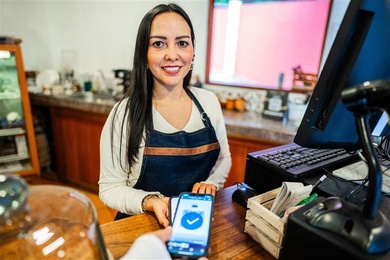Financial Health: Driving Growth in Latin America and the Caribbean

Progress on account usage across the region remains uneven. While some markets have seen a surge, others still experience lower account ownership levels and fewer compelling use cases for digital financial services.
Leading financial institutions in the LAC region play a pivotal role in closing the gap through innovation that catalyzes both access and institutional growth. IDB Invest and Consultative Group to Assist the Poorest (CGAP) identified three ways financial institutions can strengthen financial health through technology.
1. Investing in Digital Models that Put the Customer First
Rapid innovation in the financial sector makes digital transformation not just an option but a necessity. However, investing in technology isn’t enough. Customer experience must guide this innovation, and that experience must be designed to work equally well for customers in São Paulo and in remote areas of Colombia or Nicaragua.
Today, super apps (such as Mercado Pago, Rappi, and PedidosYa) bring together payments, shopping, and other services, currently focused on the urban populations of the region’s largest countries. More importantly, they offer digital accounts and credit to individuals previously excluded from formal financial systems, such as gig workers and small businesses.
As more digital financial players enter the market, customers will expect financial services to be conveniently integrated into other products, not just provided from a bank branch, website, or card. Banks should capitalize on these trends, riding the wave of new, urban, digital-first customers.
Beyond expanding their offering to digitally savvy urban customers, the region’s largest banks also have an opportunity to accelerate e-commerce and embedded finance in rural areas.
The experience of Peru and Colombia, for instance, demonstrates the viability of this pathway, with digital wallets and interoperable payment platforms expanding access to payments and credit beyond major cities.
By leveraging agent networks and partnerships with e-commerce platforms, companies, rural suppliers, and merchants, banks can position themselves at the center of this story, helping to expand their own embedded finance offerings while addressing last-mile reach and liquidity challenges for super apps in remote areas.
For smaller countries, this means opening up to more diverse forms of partnerships – with smaller regional actors, such as Hugo in Central America, or local actors, like Yalo in El Salvador. More diverse partnerships will likely require rethinking partnership strategies through efforts such as Open APIs.
Moreover, micro and small enterprises (MSEs) account for 90% of businesses in the region. These enterprises continue to face a significant financing gap. New developments in Artificial Intelligence enable better client segmentation, targeted product offerings, and lower-cost loan approvals, which can help financial institutions serve this segment profitably.
Tokenization and stablecoins are also promising to reshape financial services across the region, addressing challenges such as high remittance fees, slow cross-border transactions, and limited access for the region’s unbanked population. For example, tokenization converts real-world records, such as farmers' certifications or small business invoices, into secure digital tokens.
This enables financial service providers to verify, transfer, and leverage these assets more efficiently and securely in digital transactions.
Regional initiatives such as LNet by IDB LAB enable trusted digital identities and verifiable credentials for smallholder farmers in the region. By leveraging blockchain technology, the program addresses systemic challenges, including complex paperwork, a lack of identity verification, and financial exclusion that have traditionally limited farmers' and microfirms' access to markets and credit.
2. Catalyzing Change Across Borders: Partnership for Region-Wide Ecosystem Development
In countries such as Colombia and Brazil, the public sector has taken a leading role in driving innovation. Trends in open finance and instant payments build on forward-looking regulatory frameworks, offering a ladder for the private sector to climb. The growing availability of customer-consented data through open finance has enabled the development of more tailored products and enhanced credit scoring.
Yet, as the pace of progress accelerates in the region’s largest countries, asymmetries in infrastructure and capabilities remain. For countries that have not followed the trajectory of larger economies over the past few decades, still relying on legacy retail payment systems or vendor-driven credit infrastructure, the types of innovation seen in Open Finance may seem out of reach.
The path that worked for Brazil may not be applicable to smaller countries. However, large banks play a crucial role in helping bridge this gap. Those operating across borders can catalyze change by championing regional solutions, for example: UPI’s expansion outside India, supporting shared infrastructure solutions, or adapting proven innovations for local contexts.
3. Building Trust and Financial Well-being
Recent Global Findex data reveal that nearly 20 percent of adults in Latin America and the Caribbean (LAC) without bank accounts cite a lack of trust in financial institutions and high costs as the primary obstacles. To address these issues, large financial institutions should take responsibility not only for avoiding harm but also for actively promoting positive outcomes for customers and communities.
Financial service providers must prioritize consumer protection, data privacy, and the ethical use of innovations, such as AI, in all digital products and services. Achieving this requires collaboration among all stakeholders — fintechs, regulators, and private sector institutions — to keep customers at the center of every action. Building internal capabilities and allocating adequate resources are crucial for promptly identifying and mitigating consumer-protection risks.
Similarly, maintaining or improving customer financial well-being is positively related to higher customer loyalty, satisfaction, and bank profitability. Customers who feel their bank genuinely cares about their financial health demonstrate greater engagement, retention, and a willingness to purchase more products, thereby supporting business growth.
This involves not only providing access to services but also offering tailored products that help clients manage financial shocks, capitalize on economic opportunities, and improve their quality of life.
Financial health, in this context, extends beyond access: it reflects an individual’s ability to manage daily finances, absorb unexpected shocks, and pursue longer-term goals. This outcome benefits both individuals and institutions.
Ultimately, in the digital era, the cost of taking action is lower than ever, while the price of inaction can result in missed opportunities, increased risks, or even obsolescence. Large banks in LAC have a unique opportunity to leverage technology for both positive impact and increased profitability. Efforts to better reach all customers can simultaneously drive financial health and enhance business performance.
These topics are a fundamental part of the discussion at FinnLAC Forum 2025. Together with clients, partners, and policymakers, we aim to turn financial innovation into lasting financial health, ensuring that progress in access translates into better lives across the region.
LIKE WHAT YOU JUST READ?
Subscribe to our mailing list to stay informed on the latest IDB Invest news, blog posts, upcoming events, and to learn more about specific areas of interest.
Subscribe



